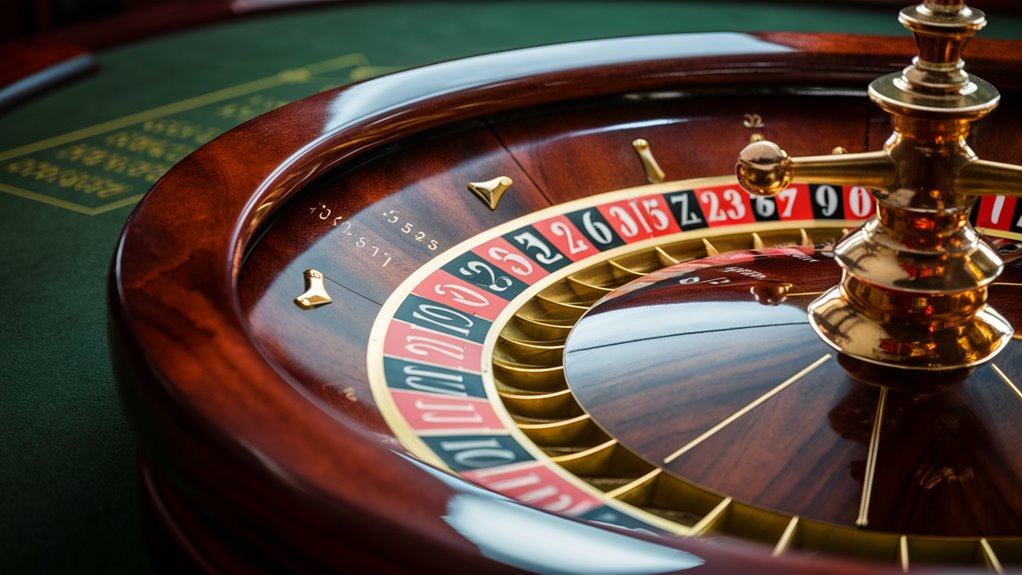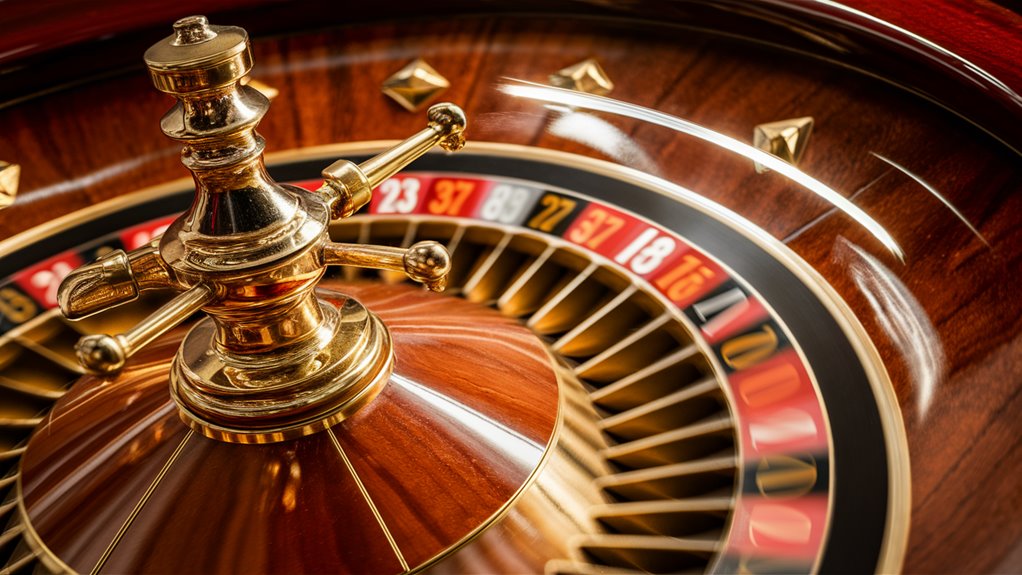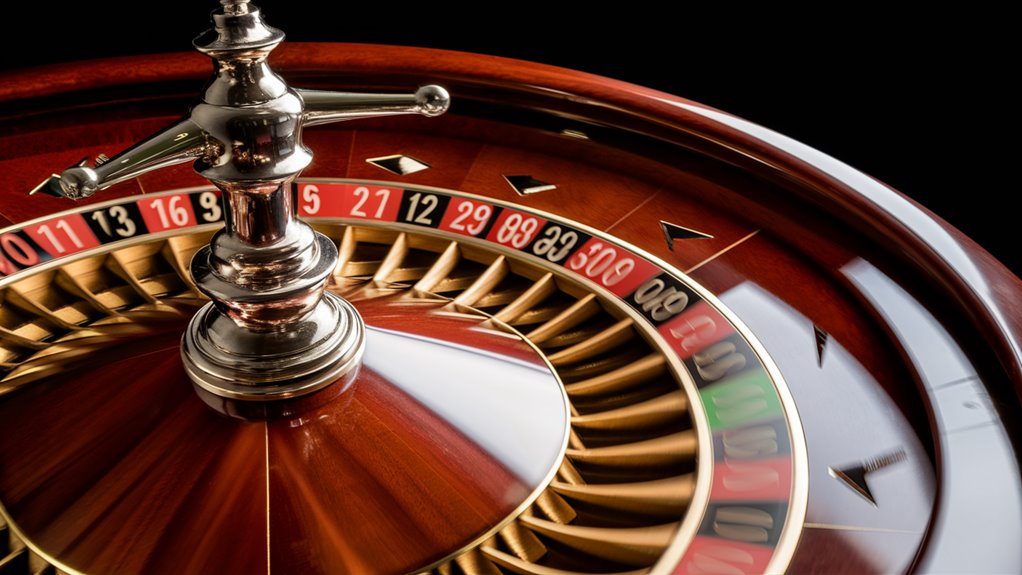
The Simple Science of Roulette: Key Physics and Math

How Roulette Works and the Odds
The deep physics and math of roulette mix high-level design and chance stats. The well-made wheel makes regular spin forces, while the ball keeps spin energy for 15-20 full turns before it stops.
The House Edge and Odds Breakdown
European roulette wheels show a 2.7% house edge with exact 1/37 odds, while American roulette types show a 2.6% gain at 1/38. These math rules are the base of the game’s odds and what players might expect to win back.
New Tech and Quality Checks
Today’s roulette wheels use top-end design rules and face hard tests. Machine-based random number systems (RNGs) and tight stats checks make sure each spin is fair, keeping the game clean and fair.
What Affects Each Spin
Many physical things change each roll:
- Wheel tilt and balance
- Ball speed and energy
- 이 자료 참고하기
- How rough the surface is
- Wind push against motion
- Heat and wet air changes
These science bits mix to set how each roll goes, making each play a new chance event using set physics rules and math facts.
What Makes the Wheel Spin
Key Forces in Roulette
The physics of a roulette wheel show many forces that set where the ball stops.
A spinning wheel shows key things about spin energy, pull toward the middle, roughness, and gravity pulls. The wheel spin makes a pulling force that keeps the ball on track, but roughness slowly cuts down its speed Petal-Like Bets for Pot-Spreading Growth
How the Ball Moves and Spins
The ball’s path is expected from its start speed and wheel spin speed. As energy drops, gravity pulls the ball down the slope.
The ball hits bumps, making wild bounces. These bumps, with the dividers between numbers, also change how likely each result is.
Deep Physical Details
The ball’s slow-down follows a drop curve because of air push and surface roughness.
Things like heat, air wetness, and how well the wheel is kept really change the basic physics.
Even a small tilt in the wheel greatly changes how the ball moves. Knowing these full-on physics ideas shows why true spin guesses are really not likely.
The Math of Chance in Roulette
Main Chance Points
While physical forces lead the roulette wheel’s workings, math of chance sets the game’s basic structure and possible results.
Simple chance ideas right away affect wins at the roulette table and set what comes back to players.
Odds for European vs American Roulette
In European roulette, with 37 numbers (0-36), the chance of hitting a certain number is 1/37 (about 2.7%).
American roulette, with an extra 00 slot, drops this chance to 1/38 (close to 2.6%).
These counts start the house edge – 2.7% for European and 5.26% for American types.
Chances for Other Bets
Out-of-box bets have different chance scenes.
Betting on red/black, odd/even, or 1-18/19-36 gives an 18/37 chance (48.6%) in European roulette.
The green zero slots stop these near 50-50 odds from being true even chances.
Each spin stands on its own, not changed by what came before, no matter what people think they see in patterns.
Today’s Random Number Tricks in Roulette
Online RNG Tech for Roulette
Random number makers (RNGs) are key in today’s digital roulette games, keeping them fair and hard to guess in online spots and digital game systems.
These smart systems use tough math to keep the game straight and give real play feels.
Real vs Digital Randomness
Old-school real roulette counts on wheel speed and how the ball moves for randomness.
But digital places use complex math-based RNG systems that make hard-to-guess number lists. These systems start with time-exact seed numbers before they use deep math changes.
Safe and Checks
Stats Tests and Okayed
Today’s RNG setups go through hard stats tests to make sure:
- Even spread in number picks
- Stats split between results
- Safe from guesses and tricks
Top Safe Parts
The best systems use:
- Machine-based random making
- Quantum bits
- Atmosphere sound checks
- Many source points
- Code safe steps
Rules and Checks
Free testing places often check these systems to prove:
- Stats randomness
- Code guts
- Right chance show
- Sticking to game laws
- Fair play rules
This full way makes sure digital roulette games give randomness that truly matches what a real roulette wheel would do.
Deep Dive: Roulette Stats and Betting Ways

Stats Roots of Roulette
Roulette stats are the math base of this well-known casino game. The main chance structure shows a house edge of 2.7% on European wheels and 5.26% on American wheels, making different win chances.
Stats study of roulette includes chance counts, number tracking, and result patterns over many spins.
Deep Pattern Checks
Betting patterns in roulette show in different planned ways. Key study bits are:
- Number count spreads
- Color follow tracks
- Sector spread checks
- Short stat changes
Ways to Bet and Plans
Adding to Bets
Betting that builds changes bet sizes based on past results. The Martingale plan is a well-known build-up way, where players up their bets after losses.
While cool in math, these ways face real limits due to table maxes and how much money you have.
Staying the Same
Flat betting keeps the same bet size all through the game, leading to more known money handling. This way lines up with the big number law, which shows that real results finally match up with what chance says over many plays.
Using Stats Well
Knowing chance spreads lets players:
- See real pattern starts
- Watch for big stat changes
- Plan money use well
- Make smart betting picks
The math layout of roulette shows that while short swings happen, long-run results line up with what chance says, making steady winning by patterns not likely.
House Edge Numbers in Roulette
US vs EU Roulette Edge Check
The count of house edge in roulette needs exact math study of pay setups and chance bits across types.
American roulette, with 38 numbers (1-36, 0, and 00), keeps a 5.26% house edge. This percent comes from the gap between the fair pay of 37:1 and the real casino pay of 35:1 for one number bets.
European roulette has a nicer 2.7% house edge because of its one-zero wheel setup with 37 numbers. The math stays the same – while fair odds would say a 36:1 pay, casinos keep their edge by paying 35:1.
Even Bet Numbers
Even-money bets like red/black and odd/even follow the same edge counts in their types.
The zero (and double zero in US roulette) makes the stat downside for players, touching all bet types the same. This base setup makes sure the house keeps its math edge no matter the bet plan.
Main House Edge Points
- Wheel Setup: Number of zeros sets base chance
- Pay Ratios: Standard 35:1 against true odds
- Bet Types: Steady edge percent across all bets
- Chance Setup: Zero spots make built-in house edge
The math frame shows that picking your game type greatly changes possible wins, with European roulette giving better odds with its one-zero setup.
Spin Forces in Roulette Wheel Moves
Wheel Spin Physics
The spin force rules of a turning roulette wheel set clear paths that decide the game’s result. These forces make the known ball path and stop spots through set physics ways.
Ball Move and Force Mix
The spin workings involve a deep mix where the ball faces an out push based on how fast it goes.
In a spin, pull to the middle pushes the ball to the wheel’s outer track, keeping a steady round move until nature steps in.
A usual spin run involves 15-20 full rounds before big energy drops happen.
Deep Path Study
The ball’s drop path follows set physics rules changed by many things:
- Wheel spin speed
- Early ball push
- How rough the surface is
- Pocket wall shapes
These mechanical parts all work together to lead to results that look random but follow set physics laws.
The ball’s move to the middle starts when spin push drops below gravity pull, making a likely slow-down path across the wheel’s slope.
New Wheel Building and Design
Top Design Rules
Modern roulette wheel design is the top of smart building, adding deep parts to make sure full fairness and randomness.
New making ways allow perfect weight spread, well-made dividers, and very set wheel sizes that keep steady spin moves.
Main Design Bits
The wheel bowl’s curve shape is a key design part, optimizing ball push while well-placed diamond bumps make wild bounce paths.
Well-made dividers keep strict 0.1mm making limits, cutting out likely pocket leans and making sure full randomness of results.
Details and Stuff Used
The center part uses top-performance ball bearings to cut down roughness points and make sure smooth spin moves.
Top-grade aluminum build gives the best weight-to-strong mix, while engineered pocket deeps of right at 13mm give ideal ball moves.
Computer checks prove making exactness, leading to a game tool that gives stats random results through smart building ways.
Main Building Features
- Curve bowl shape for best ball path
- Diamond bump spots for randomness
- High-exact dividers limits (±0.1mm)
- Advanced bearing setups for low roughness
- 13mm set pocket deep
- Top-grade stuff for strong build


